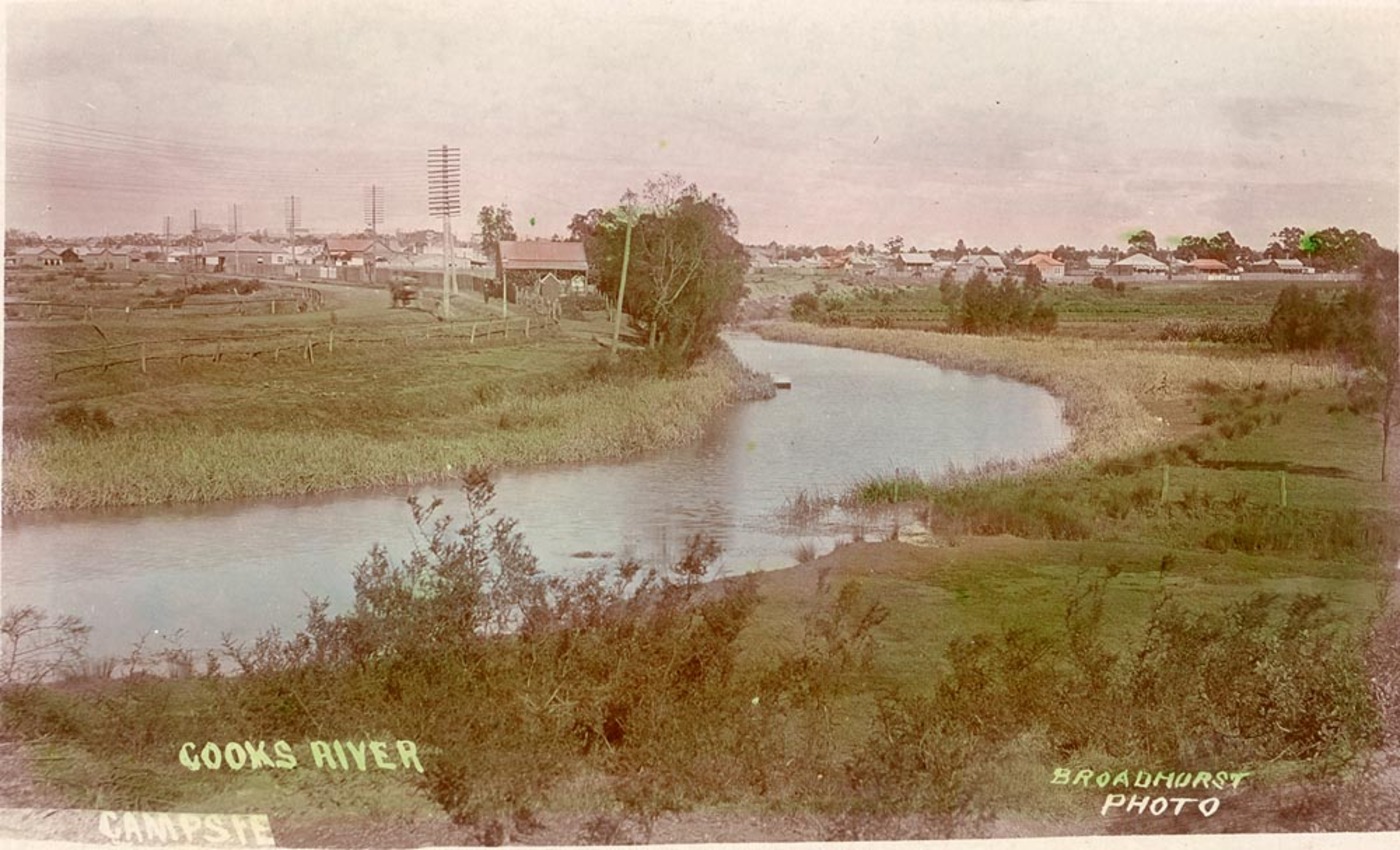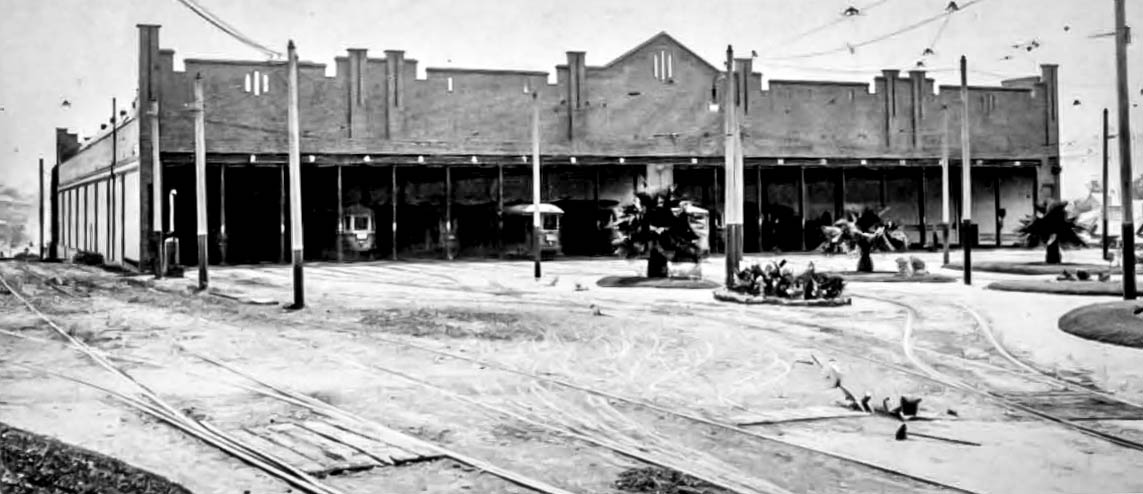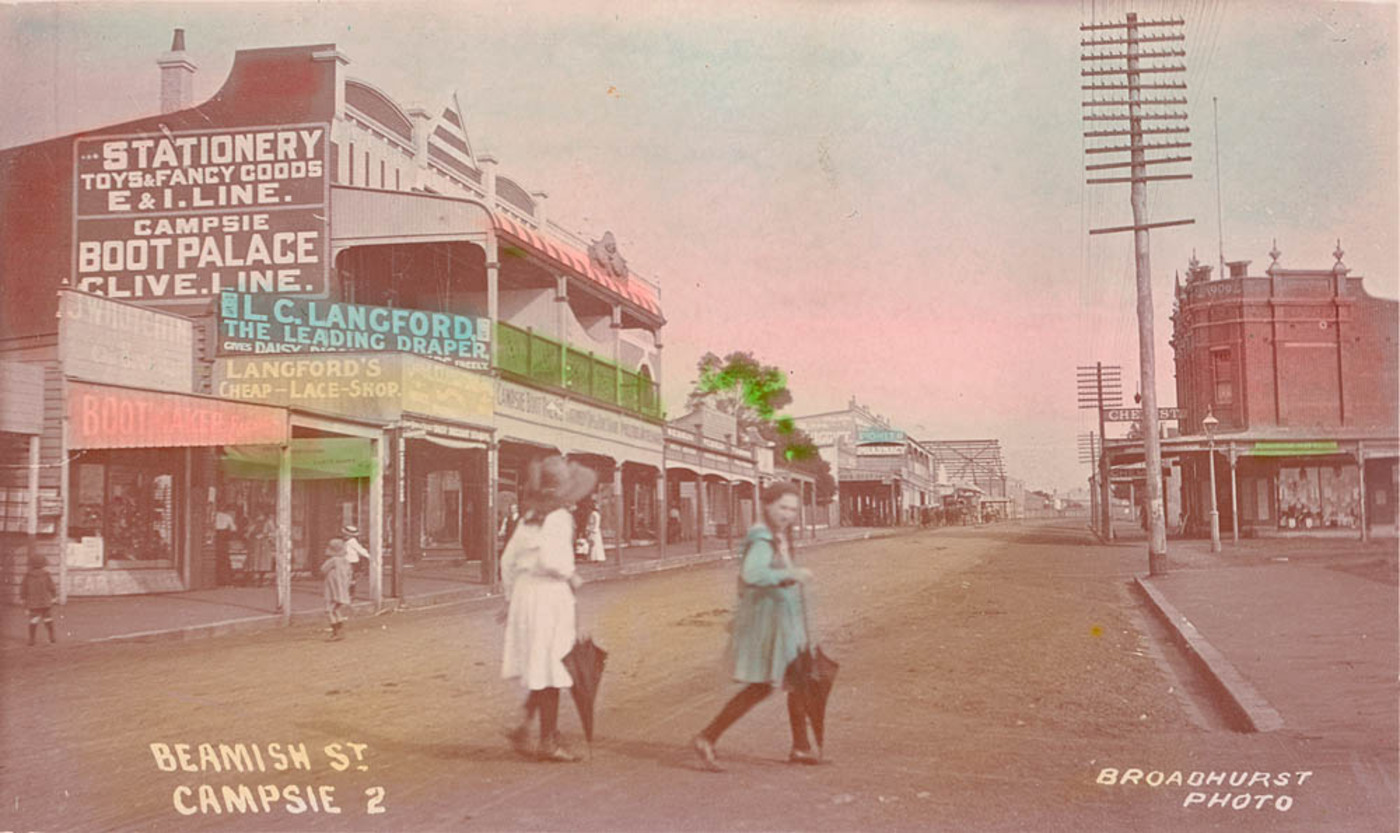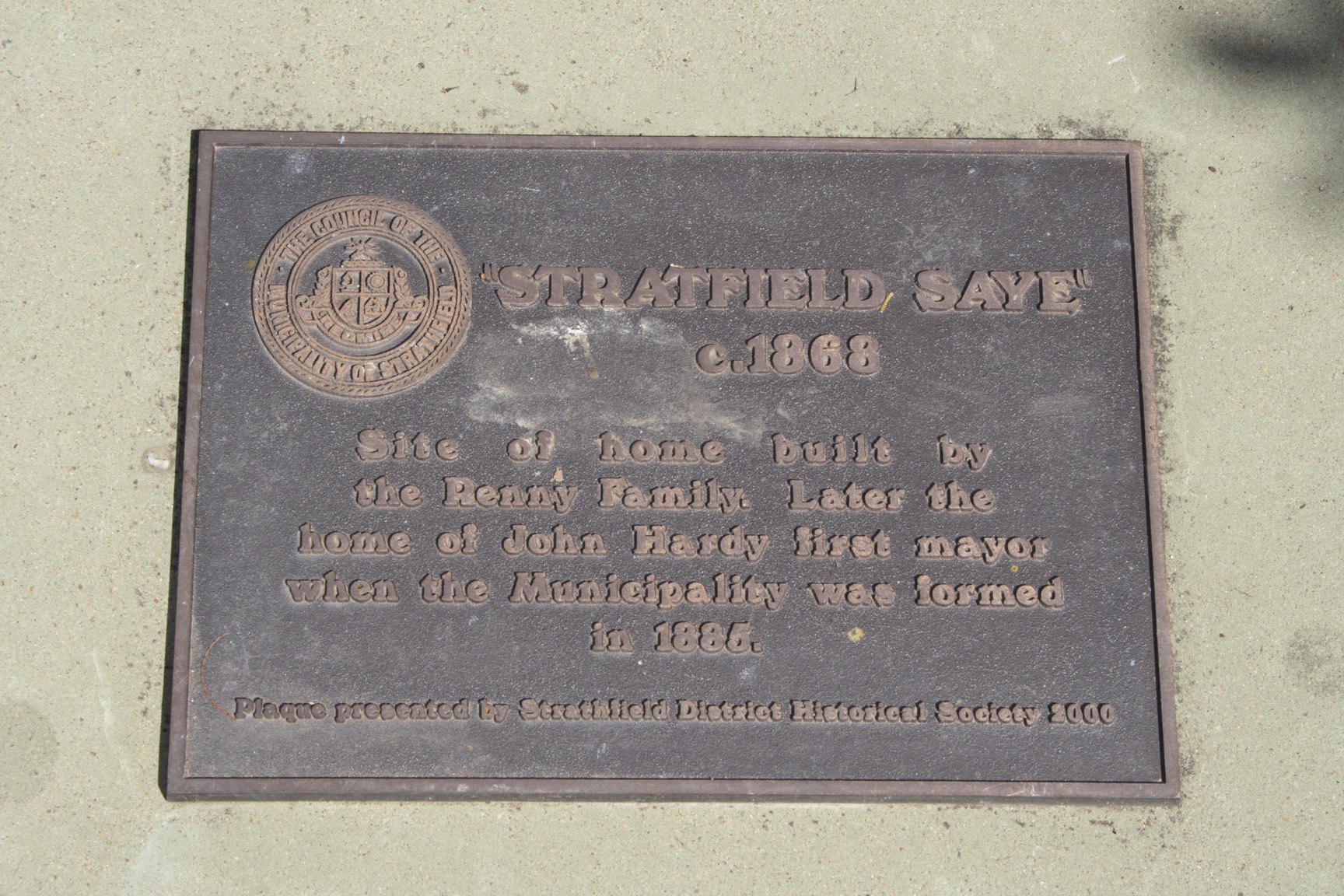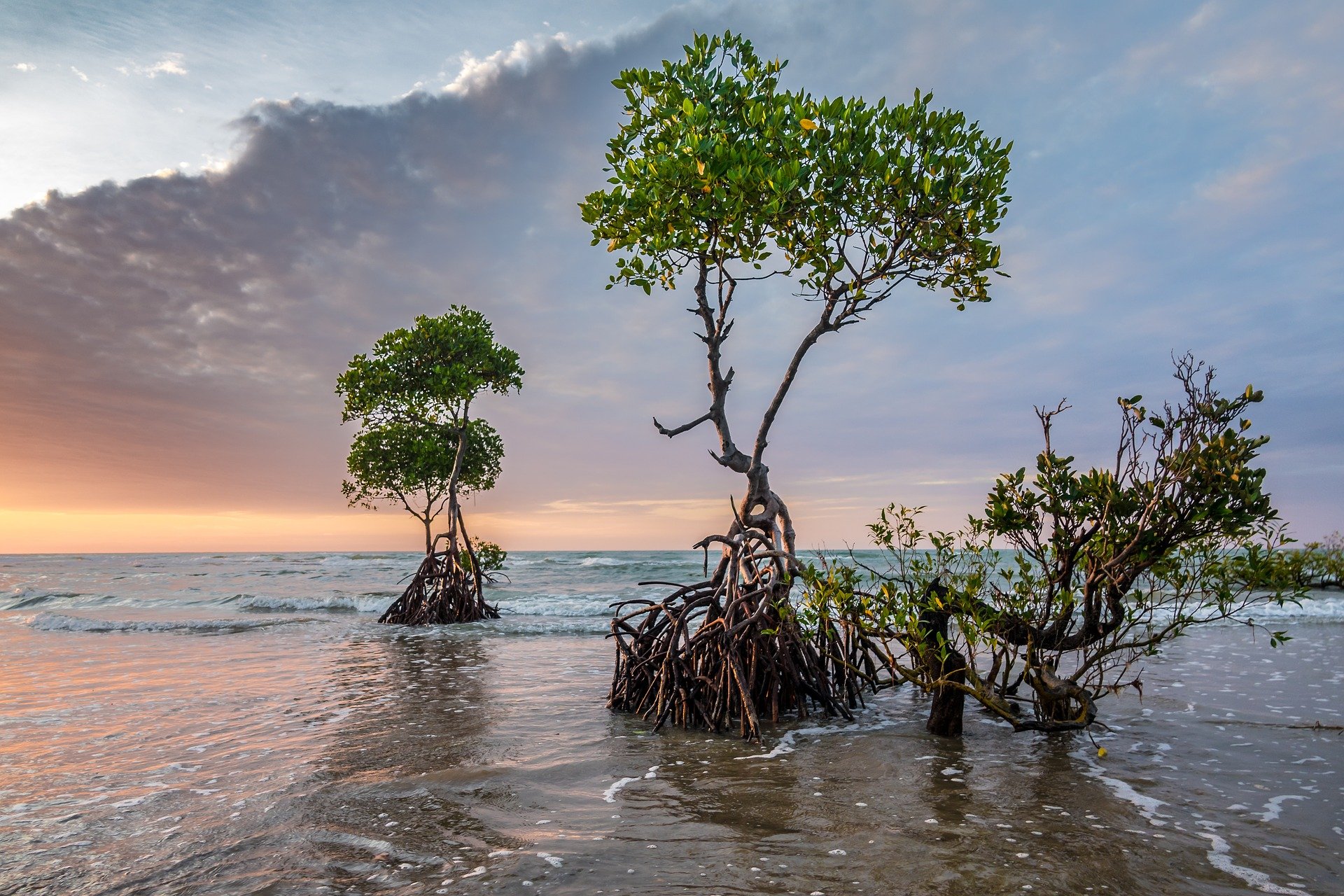|
Cooks River
The Cooks River, a semi-mature tide-dominated drowned valley estuary, is a tributary of Botany Bay, located in south-western Sydney, New South Wales, Australia. The course of the urban waterway has been altered to accommodate various developments along its shore. It serves as part of a stormwater system for the of its watershed, and many of the original streams running into it have been turned into concrete lined channels. The tidal sections support significant areas of mangrove ecosystems and are used for recreational activities. Course The river begins at Graf Park, Yagoona, then flows in a roughly north-easterly direction to Chullora. It reaches its northernmost point at Strathfield, where it leads into a concrete open canal, no more than one metre wide and thirty centimetres deep. It then heads towards the south-east. Where Cooks River runs through Strathfield Golf Course, the concrete lining has been partly removed. Here the plants have returned and have created an e ... [...More Info...] [...Related Items...] OR: [Wikipedia] [Google] [Baidu] |
Cadigal
The Gadigal, also spelled as Cadigal and Caddiegal, are a group of Aboriginal people whose traditional lands are located in Gadi, on Eora country, the location of Sydney, New South Wales, Australia. However, since the colonisation of Australia, most Gadigal people have been displaced from their traditional lands. Pre-colonisation history The Gadigal people originally inhabited the area that they call "Gadi", which lies south of Port Jackson, covering today's Sydney central business district and stretching from South Head across to Marrickville/ with part of the southern boundary lying on the Cooks River; most notably Sydney Cove is located in Gadi, the site where the first Union Jack was raised, marking the beginning of colonisation. Cadi (or Gadi) in the local Dharug dialect meant below or under, indicating that the Cadi-gal belonged to the land below Port Jackson. Philip Gidley King gave Long Cove as the western boundary which lieutenant governor David Collins identif ... [...More Info...] [...Related Items...] OR: [Wikipedia] [Google] [Baidu] |
Tide
Tides are the rise and fall of sea levels caused by the combined effects of the gravitational forces exerted by the Moon (and to a much lesser extent, the Sun) and are also caused by the Earth and Moon orbiting one another. Tide tables can be used for any given locale to find the predicted times and amplitude (or " tidal range"). The predictions are influenced by many factors including the alignment of the Sun and Moon, the phase and amplitude of the tide (pattern of tides in the deep ocean), the amphidromic systems of the oceans, and the shape of the coastline and near-shore bathymetry (see '' Timing''). They are however only predictions, the actual time and height of the tide is affected by wind and atmospheric pressure. Many shorelines experience semi-diurnal tides—two nearly equal high and low tides each day. Other locations have a diurnal tide—one high and low tide each day. A "mixed tide"—two uneven magnitude tides a day—is a third regular category. ... [...More Info...] [...Related Items...] OR: [Wikipedia] [Google] [Baidu] |
Princes Highway
Princes Highway is a major road in Australia, extending from Sydney via Melbourne to Adelaide through the states of New South Wales, Victoria (Australia), Victoria and South Australia. It has a length of (along Highway 1) or via the former alignments of the highway, although these routes are slower and connections to the bypassed sections of the original route are poor in many cases. The highway follows the coastline for most of its length, and thus takes quite an indirect and lengthy route. For example, it is from Sydney to Melbourne on Highway 1 (Australia), Highway 1 as opposed to on the more direct Hume Highway (National Highway (Australia), National Highway 31), and from Melbourne to Adelaide compared to on the Western Highway, Victoria, Western and Dukes Highways (National Highway (Australia), National Highway 8). Because of the rural nature and lower traffic volumes over much of its length, Princes Highway is a more scenic and leisurely route than the main highway ... [...More Info...] [...Related Items...] OR: [Wikipedia] [Google] [Baidu] |
Tempe, New South Wales
Tempe ( ;) is a suburb in the Inner West of Sydney, in the state of New South Wales, Australia. Tempe is located 9 kilometres south of the Sydney central business district in the Local government in Australia, local government area of Inner West Council. Tempe sits on the northern bank of the Cooks River and is separated from Sydney Airport by the Alexandra Canal, Australia, Alexandra Canal, also known as Sheas Creek. The Wolli Creek waterway also empties into the Cooks River. History Tempe was named after the mansion on the southern banks of the Cooks River in the area that is now known as Wolli Creek, New South Wales, Wolli Creek. Alexander Brodie Spark (1792–1856), an immigrant from Elgin, Moray, Elgin, Scotland, built Tempe House in 1836. It was named after the 'Vale of Tempe', a beautiful valley set at the foot of Mount Olympus in Greece, which was prominent in ancient Greek legend. Tempe House, designed by John Verge (1772–1861) in the Georgian architecture, Georgi ... [...More Info...] [...Related Items...] OR: [Wikipedia] [Google] [Baidu] |
Valley
A valley is an elongated low area often running between hills or mountains and typically containing a river or stream running from one end to the other. Most valleys are formed by erosion of the land surface by rivers or streams over a very long period. Some valleys are formed through erosion by glacial ice. These glaciers may remain present in valleys in high mountains or polar areas. At lower latitudes and altitudes, these glacially formed valleys may have been created or enlarged during ice ages but now are ice-free and occupied by streams or rivers. In desert areas, valleys may be entirely dry or carry a watercourse only rarely. In areas of limestone bedrock, dry valleys may also result from drainage now taking place underground rather than at the surface. Rift valleys arise principally from earth movements, rather than erosion. Many different types of valleys are described by geographers, using terms that may be global in use or else applied only locally ... [...More Info...] [...Related Items...] OR: [Wikipedia] [Google] [Baidu] |
Canterbury, New South Wales
Canterbury is a suburb of western Sydney, in the state of New South Wales, Australia. Canterbury is located south-west of the Sydney central business district in the City of Canterbury-Bankstown. The former City of Canterbury (New South Wales), City of Canterbury took its name from the suburb, however its administrative centre was located in the adjacent suburb of Campsie, New South Wales, Campsie, which is also a large commercial centre. History The original inhabitants of the area were the Bediagal clan of the Eora nation. The first European land grant in this suburb was of to a "very good, pious, inoffensive man", the Reverend Richard Johnson (chaplain), Richard Johnson (1753-1827), the colony's first chaplain, in 1793. He called his grant Canterbury Vale, as a tribute to Canterbury in England, and the suburb took its name from the farm. The farm extended over the area of modern-day Canterbury and Ashbury, New South Wales, Ashbury suburbs. By 1800, when it was sold to L ... [...More Info...] [...Related Items...] OR: [Wikipedia] [Google] [Baidu] |
Campsie, New South Wales
Campsie is a suburb in the state of New South Wales, Australia. Campsie is 11 kilometres south west of the Sydney central business district, on the southern bank of the Cooks River. Campsie is one of the administrative centres of the City of Canterbury-Bankstown. History Campsie was named after the Campsie parish in Stirlingshire, Scotland. Aboriginal cultures Indigenous Australians lived in this area for thousands of years. In 1770, the land along the Cooks River was explored by officers from HM Bark ''Endeavour''. European settlement In the early days of European settlement, the land in this area was mostly used for farming. The southern parts of Campsie were part of the Laycock estate that extended to most of Kingsgrove. The area between South Campsie and the Cooks River was known as the Redman estates. John Redman was granted in 1812 and he later purchased the area to the east, which was a land grant of to Thomas Capon in 1817. The railway was completed in 1895, e ... [...More Info...] [...Related Items...] OR: [Wikipedia] [Google] [Baidu] |
Belfield, New South Wales
Belfield is a suburb of Sydney, in the state of New South Wales, Australia. It is 13 kilometres (8 miles) southwest of the Sydney central business district, in the local government area of the City of Canterbury-Bankstown. History Land grants were made as early as 1810 for agricultural purposes, on the northern side of Punchbowl Road (towards Strathfield). The "Punch Bowl" was the name that early settlers gave the almost circular valley where the old road to Georges River crossed Cooks River at a ford. This is now where Georges River Road meets Punchbowl Road (the road to "The Punch Bowl") in Belfield. The name of the suburb is believed to have been created by combining the names of the two neighbouring suburbs, Belmore and Enfield. From information supplied by the Postmaster General's Department, the name "Belfield" first appeared on their records in 1930 when the Belfield branch of the ALP wrote asking that the Department establish a post office at North Belmore. Although s ... [...More Info...] [...Related Items...] OR: [Wikipedia] [Google] [Baidu] |
Concrete
Concrete is a composite material composed of aggregate bound together with a fluid cement that cures to a solid over time. It is the second-most-used substance (after water), the most–widely used building material, and the most-manufactured material in the world. When aggregate is mixed with dry Portland cement and water, the mixture forms a fluid slurry that can be poured and molded into shape. The cement reacts with the water through a process called hydration, which hardens it after several hours to form a solid matrix that binds the materials together into a durable stone-like material with various uses. This time allows concrete to not only be cast in forms, but also to have a variety of tooled processes performed. The hydration process is exothermic, which means that ambient temperature plays a significant role in how long it takes concrete to set. Often, additives (such as pozzolans or superplasticizers) are included in the mixture to improve the physical prop ... [...More Info...] [...Related Items...] OR: [Wikipedia] [Google] [Baidu] |
Strathfield
Strathfield is a suburb in the Inner West of Sydney, in the state of New South Wales, Australia. It is located 12 kilometres west of the Sydney central business district and is the administrative centre of the Municipality of Strathfield. A small section of the suburb north of the Main Suburban railway line lies within the City of Canada Bay, while the area east of The Boulevard lies within the Municipality of Burwood. North Strathfield and Strathfield South are separate suburbs to the north and south, respectively. History The Strathfield district lies between the Concord Plains to the north and the Cooks River to the south, and was originally occupied by the Wangal clan. European colonisation in present-day Strathfield commenced in 1793 with the issue of land grants in the area of "Liberty Plains", an area including present-day Strathfield as well as surrounding areas, where the first free settlers received land grants. In 1808, a grant was made to James Wilshire, which for ... [...More Info...] [...Related Items...] OR: [Wikipedia] [Google] [Baidu] |
Chullora
Chullora, a suburb in the City of Canterbury-Bankstown local government area, is located 15 kilometres west of the Sydney central business district, in the state of New South Wales, Australia. It is part of the Greater Western Sydney region. The suburb is entirely industrial and commercial, and in the 2021 census recorded a population of 14. History The suburb of Chullora was originally part of the area known as Liberty Plains, which was land given to the first free settlers who arrived in Sydney Cove on 6 January 1793. In the 1950s, many immigrants from Europe were housed in the area. Once established, they moved to other parts of Sydney. Chullora was the name used for one of the estates in this area. Chullora is an Aboriginal word meaning 'flour'. The construction of the Tip Top Bakeries has perhaps brought the suburbs back to its roots. During World War II, Chullora was selected as the site for a major wartime manufacturing plant. The site once occupied several hundred a ... [...More Info...] [...Related Items...] OR: [Wikipedia] [Google] [Baidu] |
Mangrove Forest
Mangrove forests, also called mangrove swamps, mangrove thickets or mangals, are productive wetlands that occur in coastal intertidal zones. Mangrove forests grow mainly at tropical and subtropical latitudes because mangrove trees cannot withstand freezing temperatures. There are about 80 different species of mangroves, all of which grow in areas with low-oxygen soil, where slow-moving waters allow fine sediments to accumulate.What is a mangrove forest? National Ocean Service, NOAA. Updated: 25 March 2021. Retrieved: 4 October 2021. Many mangrove forests can be recognised by their dense tangle of prop roots that make the trees appear to be standing on stilts above the water. This tangle of roots allows the trees to handle the daily rise and fall of tides, as most mangroves get flooded at least twice per day. The roo ... [...More Info...] [...Related Items...] OR: [Wikipedia] [Google] [Baidu] |
